AUDI TT ROADSTER 2008 Owners Manual
Manufacturer: AUDI, Model Year: 2008, Model line: TT ROADSTER, Model: AUDI TT ROADSTER 2008Pages: 316, PDF Size: 70.1 MB
Page 211 of 316
![AUDI TT ROADSTER 2008 Owners Manual _______________________________________________ C_l_e _a_ n_ in _____ g ___ a_n_ d ___ p_r _o _t_ e_ c_ t _i _o _ n __ lfll
•
[ i ] Tip s
Open Ve lcro fasteners on your cloth ing can d AUDI TT ROADSTER 2008 Owners Manual _______________________________________________ C_l_e _a_ n_ in _____ g ___ a_n_ d ___ p_r _o _t_ e_ c_ t _i _o _ n __ lfll
•
[ i ] Tip s
Open Ve lcro fasteners on your cloth ing can d](/img/6/57671/w960_57671-210.png)
_______________________________________________ C_l_e _a_ n_ in _____ g ___ a_n_ d ___ p_r _o _t_ e_ c_ t _i _o _ n __ lfll
•
[ i ] Tip s
Open Ve lcro fasteners on your cloth ing can damage the seat cover .
Please make sure that Ve lcro fasteners are closed .•
Plastic parts and instrument panel
Always use a c lean cloth moistened in clear water to clean these
areas . For persis tent dirt use an Audi approved
solvent -free plastic
cleaner/protectant.
& WARNING
Solvents can change the propertie s of some plastics and make it
harder for the airbag to deploy .
• Never clean the instrument p anel or the surface of Airbag
modules with cleanin g prod ucts that contain solvents .
• Products containing solvent s will make the surface of th is part
poro us.
• Serious injuries can re sult if pla stic parts come loo se when the
airbag is deployed .
• Alway s read and heed all WARNING S and the i nformation
~ page 200 .
0 Note
Cleaning agents containing solvents wil l attack the material and can
change the way it behaves. •
Instrument cluster glass
-Clean the g lass w ith a soft, damp cloth.
I n order to preserve the anti -glare properties of the instrument
c luster glass, it should o nly be cleaned wi th a so ft. dam p clot h.•
App lies to veh ic les: with nat ural leat her
Natural leather
Aud i m akes gre at effo rts to maint ain th e pr oper ties,
n atur al look and feel of interi or le ather.
Gener al
We offe r many d ifferent types of leathe r on our vehicles. Mo st are
different types of nappa leather , which has a smooth surface and
comes in various co lo rs.
The intensity o f the color determ ines the visua l characteristics and
appearance. If the surface of the leather has a typical natura l look,
then t he leather is a nappa lea ther that has bee n left in a re latively
natura l condition. This leather offers particu lar ly good comfort and
b reathes well. Fi ne veins, closed g ra ins, insect bites, skin folds, an d
subtle variations in co lor remain visib le. These characteristics
dem onstrate that the mater ial is natural.
Natura l nappa leather is not covered by a co lor finish . It is therefore
more sensitive to soil ing and wear, which is something you need to
consider if chi ldren, animals or other fac tors might prove to be
particularly hard on the leather.
By con trast, leather types that are covered by a colo red fin ish layer
are more durable. This has a positive effect on the leather's resis
tance to wea r and s oiling i n daily use . On the ot her hand, the typical
characteristics of natura l leather are barely or not apparent .
However, this does not mean that the leather itself is of inferior
qua lity .
Care and handling
Because of the exclusive nature of the types of leather that Audi
u ses and thei r unique p rope rties (suc h as sens it ivity to oi ls, g rease,
soi ling, etc .), you wi ll need to be somewhat careful w ith these
leathers, and a certain type of care is required. For example, dark .,.
Vehicle care I t •
Page 212 of 316
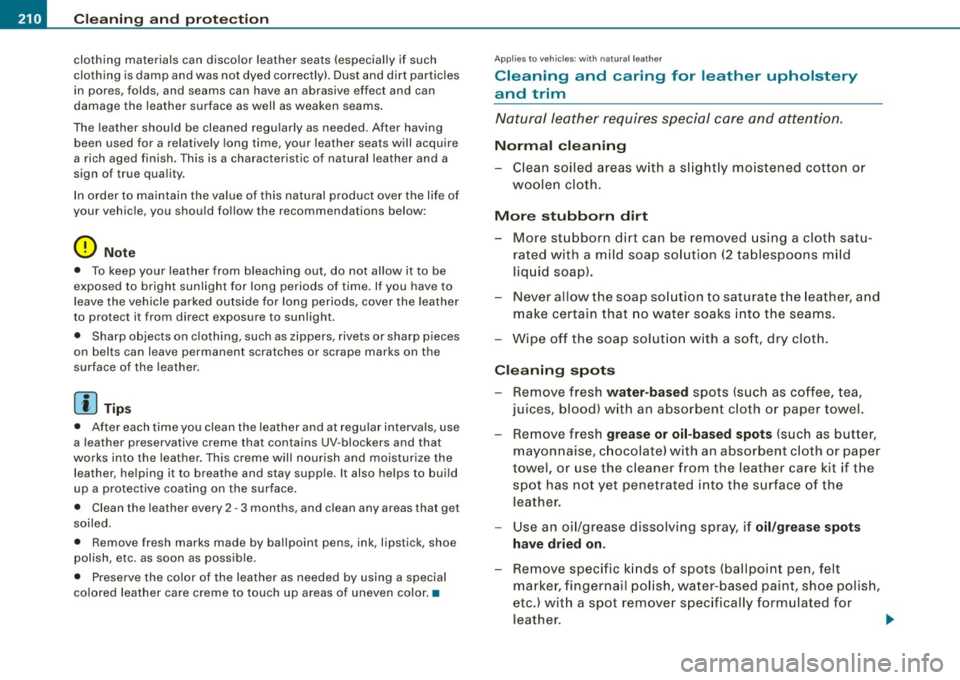
___ C_ le_ a _ n_i_n ~g _ a_ n_ d __ p_r _o _t _e _c_ t_ i_o _n ___________________________________________ _
clothing materials can discolor leather seats (especially if such
clothing is damp and was not dyed correctly). Dust and dirt particles
in pores, folds, and seams can have an abrasive effect and can
damage the leather surface as well as weaken seams.
The leather should be cleaned regularly as needed. After having
been used for a relatively long time, your leather seats will acquire
a rich aged finish. This is a characteristic of natural leather and a
sign of true quality.
In order to maintain the value of this natural product over the life of
your vehicle, you should follow the recommendations below:
0 Note
• To keep your leather from bleaching out, do not allow it to be
exposed to bright sunlight for long periods of time. If you have to
leave the vehicle parked outside for long periods, cover the leather
to protect it from direct exposure to sunlight.
• Sharp objects on clothing, such as zippers, rivets or sharp pieces
on belts can leave permanent scratches or scrape marks on the
surface of the leather.
[ i J Tips
• After each time you clean the leather and at regular intervals, use
a leather preservative creme that contains UV -blockers and that
works into the leather. This creme will nourish and moisturize the leather, helping it to breathe and stay supple. It also helps to build
up a protective coating on the surface.
• Clean the leather every 2 -3 months, and clean any areas that get
soiled.
• Remove fresh marks made by ballpoint pens, ink, lipstick, shoe
polish, etc. as soon as possible.
• Preserve the color of the leather as needed by using a special
colored leather care creme to touch up areas of uneven color. •
Applies to vehicles: w ith natu ral leather
Cleaning and caring for leather upholstery
and trim
Natural leather requires special care and attention.
Normal cleaning
-Clean soiled areas with a slightly moistened cotton or
woolen cloth.
More stubborn dirt
- More stubborn dirt can be removed using a cloth satu
rated with a mild soap solution (2 tablespoons mild
liquid soap).
- Never allow the soap solution to saturate the leather, and
make certain that no water soaks into the seams.
Wipe off the soap solution with a soft, dry cloth.
Cleaning spots
-Remove fresh water-based spots (such as coffee, tea,
juices, blood) with an absorbent cloth or paper towel.
- Remove fresh
grease or oil-based spots (such as butter,
mayonnaise, chocolate) with an absorbent cloth or paper
towel, or use the cleaner from the leather care kit if the
spot has not yet penetrated into the surface of the
leather.
- Use an oil/grease dissolving spray, if
oil/grease spots
have dried on.
- Remove specific kinds of spots (ballpoint pen, felt
marker, fingernail polish, water-based paint, shoe polish,
etc.) with a spot remover specifically formulated for leather. ..,_
Page 213 of 316
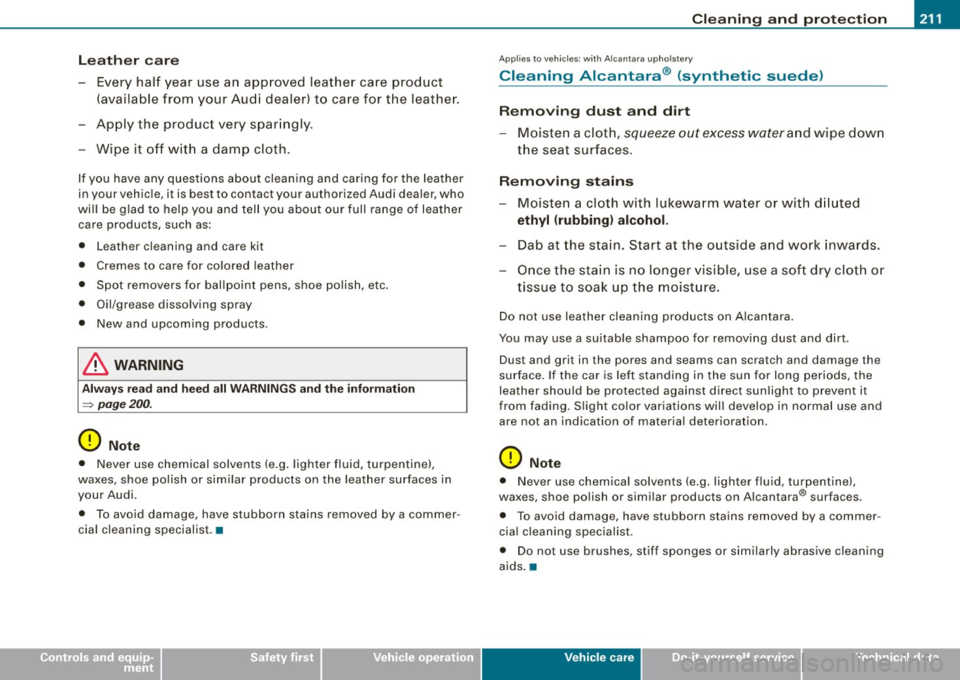
Cleaning and prote ction 1111 -------------------=-----------
•
Leath er care
- Every half year use a n app roved leather care product
(available from your Aud i dealer) to care for the leathe r.
- Ap ply the product very spar ingly .
- Wip e it off wit h a damp cloth .
If yo u have any questi ons a bout clean ing a nd caring fo r the leather
in your vehic le, it is best to contact your authorized Audi dea ler, who
wi ll be glad to help you and tell you about our full range of lea the r
care products, such as:
• Leath er cl eaning and care kit
• Cremes to care for co lored leather
• Spo t re move rs f or bal lp oin t pens, shoe polish , etc.
• Oil/gr eas e disso lving spray
• New and upcoming products.
& WARNING
Always read and heed all WARNING S and the information
=> page 200 .
0 Note
• Never use chemical so lvents (e.g . ligh ter flu id, turpentine),
waxes , shoe polish or simi lar p roduc ts on the leat her surfaces in
your Audi.
• To avoid damage, have stubborn stains removed by a commer
cia l cleaning specialist. •
Applies to veh ic les : w ith Alc a nt ara up holste ry
Cleaning Alcantara ® (synthetic suede)
Removing dust and dirt
- Moist en a cl oth, squeeze out e xcess water an d wip e down
t h e s eat su rfaces.
Removing stains
- Mo iste n a cloth w ith lukewa rm wa ter o r with d iluted
ethyl (rubbing) alcohol.
- Dab at the stain. S tart at the outside and work inwards.
O nce t he st ain is no l ong er visi ble , u se a so ft dry clo th o r
t issue to soak up th e mois ture .
Do n ot use lea ther cleaning products on A lcantara.
You may use a su itab le shampoo for remov ing dust and dirt.
Dust and grit in the por es and seams can scratch and damag e th e
s u rface . If the car is left stand ing in the sun for long peri ods, the
leather should be protected against direct sun light to prevent it
from fading. S light color var ia tions will develop in nor mal use and
are not an indication of materia l deterioration .
0 Note
• Never use chemical solvents (e .g. lighter fluid , turpentine),
waxes, shoe polish or similar products on Alcantara ® surfaces.
• To avoid damage , have stubborn stains removed by a commer
cia l cleaning specialist .
• Do no t use brushes, stiff sponges or similarly abrasive c leaning
ai ds. •
Vehicle care I t •
Page 214 of 316
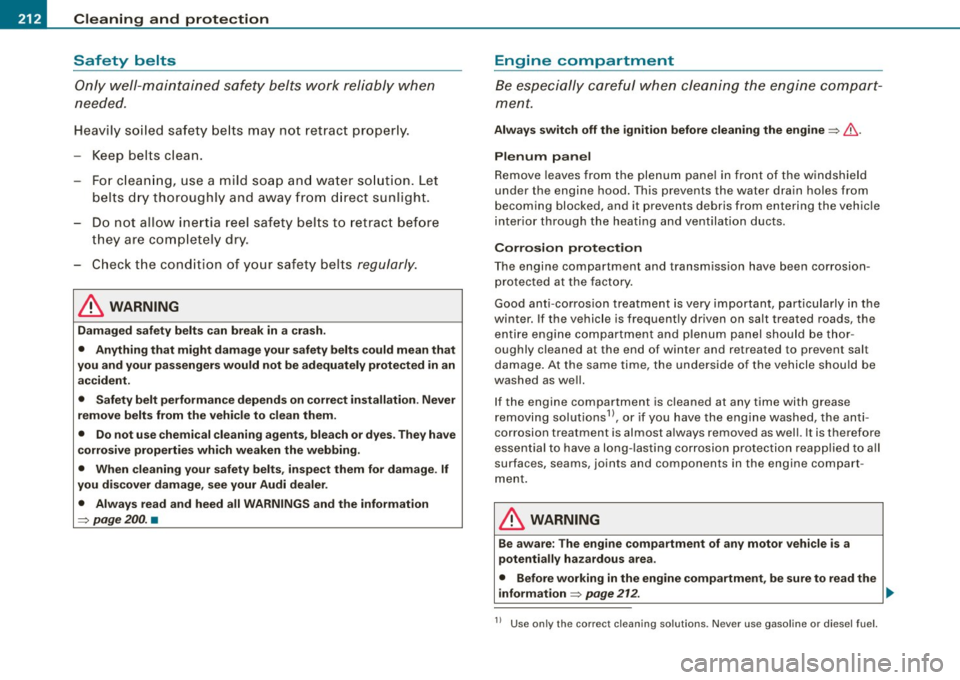
-Cleaning and prot
ection
-~--------------
Safety belts
Only well-maintained safety belts work reliably when
needed.
H eavily soiled safety be lts may no t retract properly.
- Keep belts c lean.
- For clean ing, use a mild soa p an d wa ter so luti on. Let
belts dry thoroughly and away from d irect sunlight.
- D o not allo w inertia reel safe ty belts to retra ct before
they are com pletely dry .
- Check the condition of your safety belts
regularly .
& WARNING
Damaged safety belt s can break in a crash .
• Anything that might damage your safety belts could mean that
y ou and yo ur pas senger s would not be adequatel y prote cted in an
accident .
• Safety belt performance depend s on correct in stallation . Never
remove belt s from the vehicle to clean them.
• Do not u se chemi cal cleaning agents , blea ch or dyes . They h ave
c orrosive propertie s wh ich weaken the webbing.
• When cleaning your safety belts , in spect them for dam age . If
you discover damage, see your Audi dealer .
• Alway s read and heed all WARNINGS and the infor mation
=> page 200 . •
Engine compartment
Be es pecially caref ul when cle aning the engine compart
ment.
Alwa ys swit ch off the ignition before cle aning the engine => & .
Plenum pan el
Remove leaves from the plenum pane l in front of the w indshield
under the engine hood. This prevents the water drain holes from
becoming blocked, and it prevents debris from entering the vehicle
inter ior through the heating and ventilation ducts.
Corrosion protection
The engine compartment and transmission have been corrosion
pro tected at the factory.
Good anti -co rros io n treatment is very important, particularly in the
winter. If the vehicle is frequent ly driven on salt treated roads, the
enti re eng ine compartmen t and p lenum panel should be thor
oughly cleaned at the end of winter and retreated to prevent salt
damage . At the same time, the unde rside o f the vehicle shou ld be
washed as we ll.
I f the engine compartment is cleaned at any time with grease
removing solut ions
ll, or if you have the engine washed, the anti
corrosion treatment is almost a lways removed as well. It is therefore
essential to have a long-lasting corrosio n pro tec tion reapp lied to a ll
surfaces, seams, joints and components in the engine compart
ment .
& WARNING
Be awa re: Th e engine comp artment of any motor vehicle is a
potentially hazardou s area .
• Befo re working in the eng ine compartme nt, be sure to read the
i nformat ion =>
page 212 . .,.
11 Use on ly the correct cleaning so lutions. Never use gasol ine or diesel fuel.
Page 215 of 316
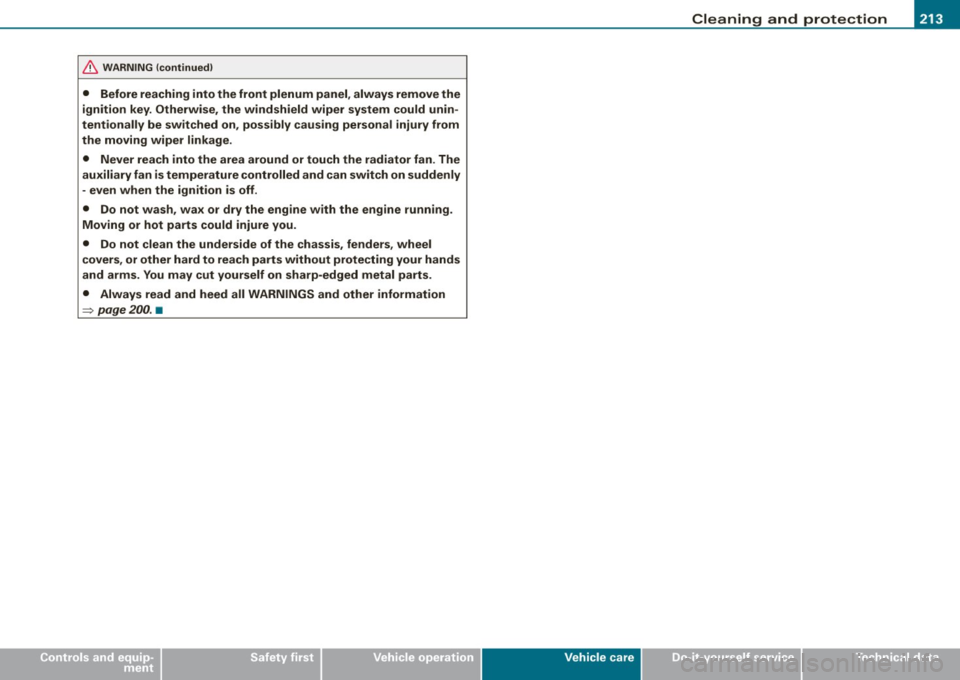
Cleaning and protection -
----------------
•
& WARNING (continued )
• Before reaching into the front plenum panel , always remove the
ignition key . Otherwise , the windshield wiper system could unin
tent ionally be sw itched on, possibly caus ing personal injury from
the moving wiper linkage.
• Never reach into the area around or touch the radiator fan. The
auxiliary fan is temperature controlled and can switch on suddenly
- even when the ignition is off .
• Do not wash, wax or dry the engine with the engine running .
Moving or hot parts could injure you .
• Do not clean the underside of the chassis , fenders, wheel
covers , or other hard to reach parts without protecting your hands
and arms. You may cut yourself on sharp-edged metal parts .
• Always read and heed all WARNINGS and other information
=> page 200. •
Vehicle care I t •
Page 216 of 316
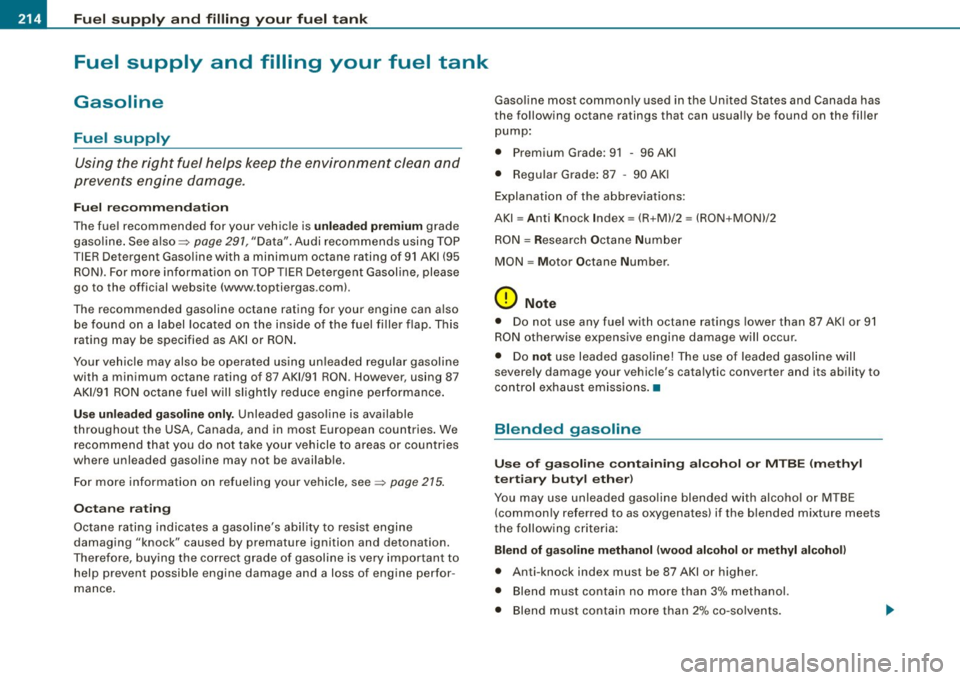
Fue l sup ply and fillin g your fu el tank
Fuel supply and filling your fuel tank
Gasoline
Fuel supply
Using the right fuel helps keep the environment clean and
prevents engine damage.
Fu el r eco mmend ati on
The fuel recommended for your vehicle is unleaded pr em ium grade
gasoline . See also =>
page 291, "Data". Audi recommends using TOP
TIER Detergent Gasoline with a minimum octane rating of 91 AKI (95
RON). For more information on TOP TIER Detergent Gasoline, please
go to the official website (www.toptiergas.coml.
The recommended gasoline octane rating for your engine can a lso
be found on a label located on the ins ide of the fuel filler flap. This
rating may be specified as AKI or RON .
Your vehicle may also be operated us ing un leaded regu lar gasoline
with a minimum octane rating of 87 AKl/91 RON. However, using 87
AKl/91 RON octane fuel will slight ly reduce engine performance .
Use u nlea d ed ga solin e only. Unleaded gasoline is available
throughout the USA, Canada, and in most European countries . We
recommend that you do not take your vehicle to areas or countries
where unleaded gasoline may not be available.
For more information on refueling your vehicle, see=>
page 215 .
O ctane ra tin g
Octane rating indicates a gasoline's abil ity to resist engine
damaging "knock" caused by premature ignition and detonation.
Therefore, buying the correct grade of gasoline is very important to help prevent possible engine damage and a loss of engine perfor
mance. Gasoline most commonly used in the United States and Canada has
the following octane ratings that can usual ly be found on the filler
pump:
• Premium Grade: 91 -96 AKI
• Regular Grade : 87 -90 AKI
Explanation of the abbreviations:
AKI = Anti Knock Index= (R +Ml/2 = (RON +MON)/2
RON= Research Octane Number
MON = M otor Octane Number .
0 Note
• Do not use any fuel with octane ratings lower than 87 AK I or 91
RON otherwise expensive engine damage will occur .
• Do
not use leaded gaso line! The use of leaded gasoline will
severely damage your vehic le's cata lytic converter and its abi lity to
contro l exhaust emissions. •
Blended gasoline
Use o f gaso line containin g alco ho l o r MTB E (met hy l
t e rt iary butyl e th er)
You may use unleaded gaso line blended with alcohol or MTBE
(common ly referred to as oxygenates) if the blended mixture meets
t he fo llowing criteria:
Bl end of g asoline m eth anol (wood alcoho l or methyl al coh ol)
• Anti-knock index must be 87 AKI or higher.
• Blend must contain no more than 3% methanol.
• Blend must contain more than 2% co-so lvents.
Page 217 of 316
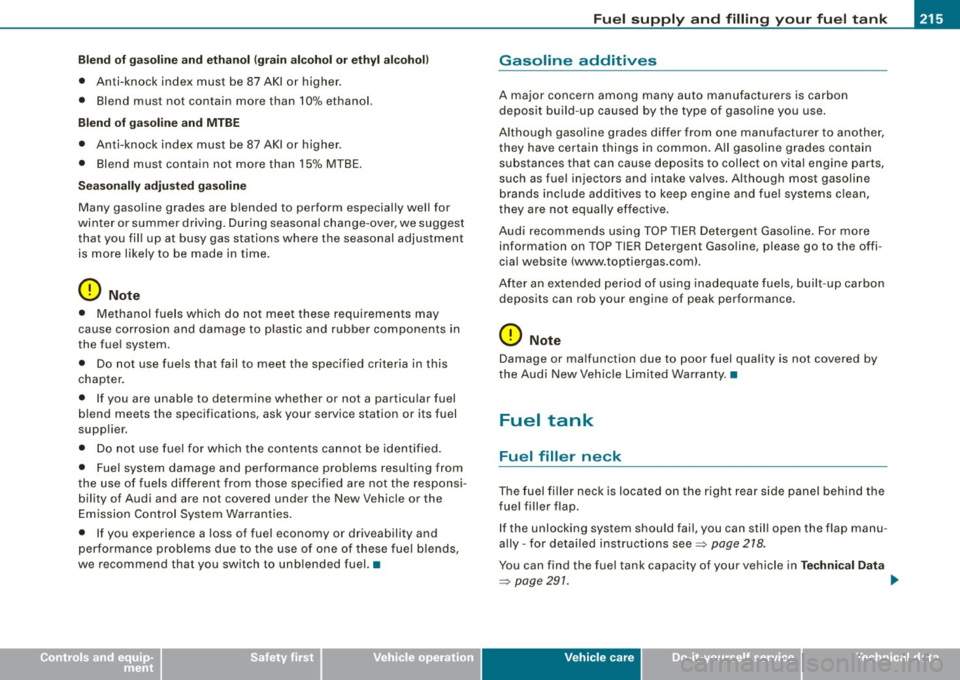
Fuel supply and filling your fuel tank -___________ ...:._:......:,_______;::;...a,__ __
•
Blend of gasoline and ethanol (grain alcohol or ethyl alcohol)
• Anti -knock index must be 87 AKI or higher.
• Blend must not contain more than
10% ethanol.
Blend of gasoline and MTBE
• Anti-knock index must be 87 AKI or higher.
• Blend must contain not more than
15% MTBE.
Seasonally adjusted gasoline
Many gasoline grades are blended to perform especially well for
winter or summer driving . During seasona l change -over, we suggest
that you fil l up at busy gas stations where the seasonal adjustment
is more likely to be made in time.
0 Note
• Methanol fuels which do not meet these requirements may
cause corrosion and damage to p lastic and rubber components in
the fue l system.
• Do not use fue ls that fail to meet the specified criteria in this
chapter .
• If you are unable to determine whether or not a particu lar fuel
blend meets the specifications, ask your service station or its fuel
suppl ier.
• Do not use fue l for which the contents cannot be identified.
• Fuel system damage and performance problems resu lting from
the use of fuels different from those specified are not the responsi
bility of Audi and are not covered under the New Vehicle or the
Emission Control System Warranties.
• If you experience a loss of fuel economy or driveability and
performance problems due to the use of one of these fuel blends,
we recommend that you switch to unblended fuel. •
Gasoline additives
A major concern among many auto manufacturers is carbon
depos it build -up caused by the type of gasoline you use.
Although gasoline grades differ from one manufacturer to another,
they have certain things in common. All gaso line grades contain
substances that can cause deposits to collect on vita l engine parts,
such as fue l injectors and intake valves. Although most gasoline
brands include additives to keep engine and fue l systems clean,
they are not equally effective.
Audi recommends using TOP TIER Detergen t Gasoline. For more
information on TOP TIER Detergent Gasoline, please go to the offi
cial website (www.toptiergas .coml.
A ft er an extended period of using inadequate fuels, built-up carbon
deposits can rob you r engine of peak performance.
(D Note
Damage or malfunction due to poor fuel qua lity is not covered by
the Audi New Vehicle Limited Warranty .•
Fuel tank
Fuel filler neck
The fuel filler neck is located on the right rear side panel behind the
fue l filler f lap.
If the unlocking system should fai l, you can stil l open the flap manu
a lly -for detai led instructions see=>
page 218.
You can find the fuel tank capacity of your vehicle in Technical Data
=> page 291. _.,
Vehicle care I t •
Page 218 of 316
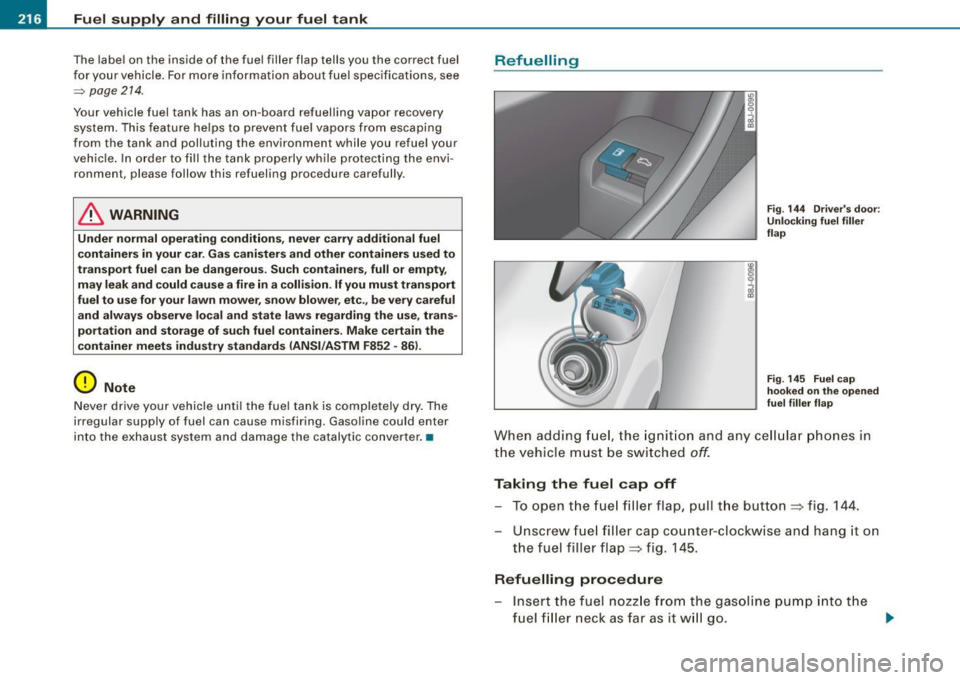
Fuel supply and filling your fuel tank
The label on the inside of the fuel filler flap tells you the correct fuel
for your vehicle. For more information about fuel specifications, see
~ page 214.
Your vehicle fuel tank has an on -board refuelling vapor recovery
system. This feature helps to prevent fuel vapors from escaping
from the tank and polluting the environment while you refuel your
vehicle. In order to fill the tank properly while protecting the envi
ronmen t, please follow this refueling procedure carefully.
& WARNING
Under normal operating conditions, never carry additional fuel
containers in your car. Gas canisters and other containers used to
transport fuel can be dangerous. Such containers, full or empty,
may leak and could cause a fire in a collision. If you must transport
fuel to use for your lawn mower, snow blower, etc ., be very careful
and always observe local and state laws regarding the use, trans
portation and storage of such fuel containers . Make certain the
container meets industry standards (ANSI/ASTM F852 -861.
0 Note
Never drive your vehicle until the fuel tank is completely dry. The
irregular supply of fuel can cause misfiring . Gasoline could enter
into the exhaust system and damage the catalytic converter. •
Refuelling
Fig. 144 Driver's door:
Unlocking fuel filler
flap
Fig . 145 Fuel cap
hooked on the opened
fuel filler flap
When adding fuel, the ignition and any cellular phones in
the vehicle must be switched
off.
Taking the fuel cap off
To open the fuel filler flap, pull the button ~ fig. 144.
Unscrew fuel filler cap counter-clockwise and hang it on
the fuel filler flap~ fig. 145 .
Refuelling procedure
Insert the fuel nozzle from the gasoline pump into the
fuel filler neck as far as
it will go. .,_
Page 219 of 316
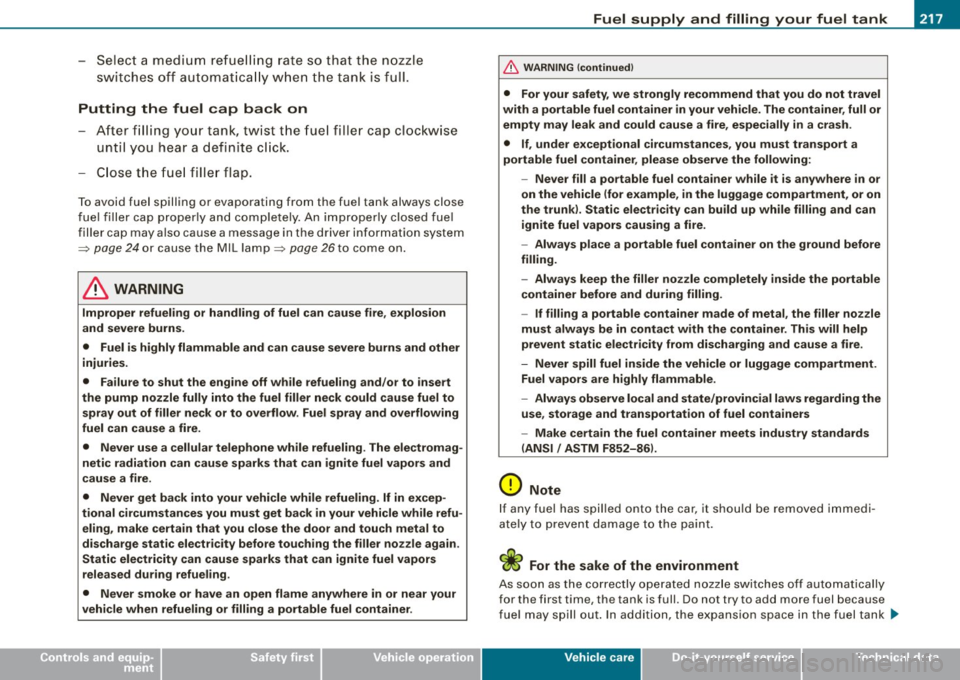
_____________________________________ F_ u_ e_l _s _u-= pc...:... p_ly =--- a_ n_ d_ f_ i_ ll _in -=: gc.. y -=--- o-u_ r_ fu_ e_l _t _a _n_ k __ fflllll
•
- Select a medium refuelling rate so that the nozzle
switches off automatically when the tank is full.
Putting the fuel cap back on
- After filling your tank, twist the fuel filler cap clockwise
until you hear a definite click.
- Close the fuel filler flap.
To avoid fuel spilling or evaporating from the fuel tank always close
fuel filler cap properly and completely. An improperly closed fuel
filler cap may also cause a message in the driver information system =>
page 24 or cause the MIL lamp=> page 26 to come on.
& WARNING
Improper refueling or handling of fuel can cause fire, explosion
and severe burns .
• Fuel is highly flammable and can cause severe burns and other
injuries.
• Failure to shut the engine off while refueling and/or to insert
the pump nozzle fully into the fuel filler neck could cause fuel to
spray out of filler neck or to overflow. Fuel spray and overflowing
fuel can cause a fire.
• Never use a cellular telephone while refueling . The electromag
netic radiation can cause sparks that can ignite fuel vapors and
cause a fire .
• Never get back into your vehicle while refueling. If in excep
tional circumstances you must get back in your vehicle while refu
eling, make certain that you close the door and touch metal to
discharge static electricity before touching the filler nozzle again.
Static electricity can cause sparks that can ignite fuel vapors
released during refueling.
• Never smoke or have an open flame anywhere in or near your
vehicle when refueling or filling a portable fuel container.
& WARNING (continued)
• For your safety, we strongly recommend that you do not travel
with a portable fuel container in your vehicle. The container, full or empty may leak and could cause a fire, especially in a crash .
• If, under exceptional circumstances, you must transport a
portable fuel container, please observe the following: -Never fill a portable fuel container while it is anywhere in or
on the vehicle (for example, in the luggage compartment, or on
the trunk). Static electricity can build up while filling and can ignite fuel vapors causing a fire.
- Always place a portable fuel container on the ground before
filling.
- Always keep the filler nozzle completely inside the portable
container before and during filling.
- If filling a portable container made of metal, the filler nozzle
must always be in contact with the container. This will help
prevent static electricity from discharging and cause a fire.
- Never spill fuel inside the vehicle or luggage compartment.
Fuel vapors are highly flammable.
- Always observe local and state/provincial laws regarding the
use, storage and transportation of fuel containers
- Make certain the fuel container meets industry standards
(ANSI / ASTM F852-86l.
(D Note
If any fuel has spilled onto the car, it should be removed immedi
ately to prevent damage to the paint.
<£> For the sake of the environment
As soon as the correctly operated nozzle switches off automatically
for the first time, the tank is full. Do not try to add more fuel because
fuel may spill out. In addition, the expansion space in the fuel tank ..,_
Vehicle care
I t •
Page 220 of 316
![AUDI TT ROADSTER 2008 Owners Manual Fuel supply and filling y our fu el ta nk
will be filled -causing the fuel to overflow when it becomes warm
and pollute the environment.
[ i ] Tips
• Running your engine wh AUDI TT ROADSTER 2008 Owners Manual Fuel supply and filling y our fu el ta nk
will be filled -causing the fuel to overflow when it becomes warm
and pollute the environment.
[ i ] Tips
• Running your engine wh](/img/6/57671/w960_57671-219.png)
Fuel supply and filling y our fu el ta nk
will be filled -causing the fuel to overflow when it becomes warm
and pollute the environment.
[ i ] Tips
• Running your engine while refuel ling may cause vapors to
escape or even fuel to spill out of the tank . This would then shut off
the fue l nozzle before the tank is full.
• Do not refuel your vehicle with the ignition switched on . The fuel
gauge may otherwise not indicate the correct fuel level after
refuel ling .•
Unlocking the fuel filler flap by hand
You c an open the fuel filler flap by hand i f the p ower
locking system should fail .
Fig . 14 6 Lugg age
co mp artm ent : Cove r in
t h e r igh t-side interi or
tri m
If the power loc king syst em sho uld fa il, you can still open
the flap manually :
- Ope n the rear lid .
Open the round cover in the right -s ide interior trim.
Remove the red plastic knob from its reta iner . -
Pull the plastic cord in the direction of the arrow to
unlock the fuel filler flap~ fig. 146 . •